| Pages:
1
2 |
LoveLightPeace
Oud Lover
 
Posts: 19
Registered: 6-11-2012
Member Is Offline
|
|
question about spruce oud boards
the guy who is making me a custom oud said to me that the front board of the oud is made up of spruce, and i forget wat terminology he used but he
said he does not stain/paint the wood, because it's better to leave it as is for ouds!
note: he did not use the exact words "stain/paint" but im sure the people here who are pros know wat that process is called whereby the wood becomes
more shiny as if oily!
my questions are:
1-is spruce good for the front board?
2-was he right in saying that there is no need to do anything with the spruce and to leave it as is?
here's the pic of the oud he's making me:

|
|
|
dkhoury35
Oud Junkie
    
Posts: 181
Registered: 11-3-2010
Location: Melbourne Australia
Member Is Offline
Mood: IM IN THE M-OUD
|
|
Who is making your oud if you dont mind me asking
|
|
|
Brian Prunka
Oud Junkie
    
Posts: 2916
Registered: 1-30-2004
Location: Brooklyn, NY
Member Is Offline
Mood: Stringish
|
|
Yes to both questions.
|
|
|
LoveLightPeace
Oud Lover
 
Posts: 19
Registered: 6-11-2012
Member Is Offline
|
|
he's an iranian oud maker in toronto canada, his name is "esfehani nejad"
he's charging me 800 bucks though! the woods he uses (for bowl & neck) are maple, rosewood, and walnut, he's given me time to change my mind on
the wood of the bowl & neck, which one do you think i should go for?
|
|
|
Brian Prunka
Oud Junkie
    
Posts: 2916
Registered: 1-30-2004
Location: Brooklyn, NY
Member Is Offline
Mood: Stringish
|
|
$800 is inexpensive for a handmade oud.
I would choose walnut personally, but it is up to you. The bowl differences are largely aesthetic, though they do have a small impact on the
sound.
|
|
|
fernandraynaud
Oud Junkie
    
Posts: 1865
Registered: 7-25-2009
Location: San Francisco, California
Member Is Offline
Mood: m'Oudy
|
|
The traditional way is to leave the soundboard unfinished. But after a few years they generally look dirty, frankly not very pretty. There does not
seem to be any disadvantage to light use of shellac, and a lot of benefit. Look at a 50 year old Martin guitar, and there are many. I don't think it's
realistic to play an instrument like a laboratory procedure. Accidents happen, and a shellac'ed soundboard can be wiped clean. I'd vote for French
Polishing with shellac or brushing it on dilute and sanding down to a semi-gloss. But ask for real flake shellac in alcohol, the canned stuff is not
as good, dries a bit gummy. Also, and this is my personal preference, and not traditional, if the fingerboard is not ebony, for myself I would ask if
he can coat it with something hard like Tru-Oil as used on rifle stocks so it resists wear from the wound strings, and you don't have to plane it
every few years. But if you want a completely traditional oud, just let him do it his way.
|
|
|
Aymara
Oud Junkie
    
Posts: 1162
Registered: 10-14-2009
Location: Germany / Ruhr Region
Member Is Offline
Mood: No Mood
|
|
Correct.
| Quote: |
I'd vote for French Polishing with shellac ...
|
Mee too ... shellac flakes.
And besides ebony fingerboards I like rosewood bowls for that deep warm bass and spruce soundboards, that are sealed. I once had the chance to buy a
used great oud with an unsealed soundboard and there was an ugly dark stain from the former players arm ... buah ... that was a no-go for my
taste.
The downside of a thin shellac protection is so minimal compared to the advatanges, that I would never buy an oud with an unsealed soundboard.
The same with my opinion, but I'm more extreme and say: Tradition isn't always the best way to go.
Other opinions vary 
Greetings from Germany
Chris
|
|
|
LoveLightPeace
Oud Lover
 
Posts: 19
Registered: 6-11-2012
Member Is Offline
|
|
Quote: Originally posted by fernandraynaud  | | The traditional way is to leave the soundboard unfinished. But after a few years they generally look dirty, frankly not very pretty. There does not
seem to be any disadvantage to light use of shellac, and a lot of benefit. Look at a 50 year old Martin guitar, and there are many. I don't think it's
realistic to play an instrument like a laboratory procedure. Accidents happen, and a shellac'ed soundboard can be wiped clean. I'd vote for French
Polishing with shellac or brushing it on dilute and sanding down to a semi-gloss. But ask for real flake shellac in alcohol, the canned stuff is not
as good, dries a bit gummy. Also, and this is my personal preference, and not traditional, if the fingerboard is not ebony, for myself I would ask if
he can coat it with something hard like Tru-Oil as used on rifle stocks so it resists wear from the wound strings, and you don't have to plane it
every few years. But if you want a completely traditional oud, just let him do it his way. |
Thank you very much!
some more (hopefully) quick questions:
1-Where can one purchase real flake shellac in alcohol instead of canned?
2-and when you say "the canned stuff dries a bit gummy" do you mean it literally has a "sticky/viscid" texture to it after it dries? (English is my
second language sorry!)
3-so i should tell the luthier to go light (not use too much) on the shellac ?
|
|
|
Aymara
Oud Junkie
    
Posts: 1162
Registered: 10-14-2009
Location: Germany / Ruhr Region
Member Is Offline
Mood: No Mood
|
|
We bought such flakes from a craftman supply shop in Arnhem, Netherlands. But I don't know, if they ship outside Europe. They have shellac in red,
honey and clear.
http://www.baptist.nl
You can contact them by mail in English.
Greetings from Germany
Chris
|
|
|
fernandraynaud
Oud Junkie
    
Posts: 1865
Registered: 7-25-2009
Location: San Francisco, California
Member Is Offline
Mood: m'Oudy
|
|
On the American continent we have these guys, shellac is what they DO.
http://www.shellac.net/
I'm eying their black shellac for my Sukar 14's bowl.
The nature of shellac is that it's brittle. The flakes are like thin microscope coverslips. You dissolve it in ethanol. It dries shiny and brittle.
Acoustically transparent, maybe even sonically helpful. I believe that the gummier the finish the more it dampens the soundboard. The canned stuff is
designed for furniture, where you want more flex, and use thicker layers. I don't know what they add, but it's also sitting on the shelf a long time.
It's different, it dries more flexible. With just alcohol and shellac you control it better. If your guy doesn't know how to French Polish, ask him to
just mix it thin and brush it on, let it dry then work it down with very fine steel wool, then another few coats the same way. On the last coat I use
very fine "plastic steel wool" - it's subtle egg-shell semi-glossy, and not cheap-shiny looking. Yet you can play the oud without always worrying
about stains, and with some care it might look nice when you're old and can't remember what that pear-shaped instrument is called - "It's a ... a...
bazu ... mando ... loo ... ANYWAY it's purdy and I'll play you a ta .. tax .. mak ... a TUNE!"
|
|
|
Aymara
Oud Junkie
    
Posts: 1162
Registered: 10-14-2009
Location: Germany / Ruhr Region
Member Is Offline
Mood: No Mood
|
|
... to watch the excellent tutorials which can be found on Youtube ... search for Shellac and French Polish.
Greetings from Germany
Chris
|
|
|
fernandraynaud
Oud Junkie
    
Posts: 1865
Registered: 7-25-2009
Location: San Francisco, California
Member Is Offline
Mood: m'Oudy
|
|
Yeah, yeah. And if you can do a good job from those tutorials, so can I. It never quite works so well in practice, and I've watched a lot of people
who claim they know how push that rag ball around in desperation and touch up and touch up. Forget it. The old Belgian Polish technique with the brush
is what works for me.
|
|
|
Aymara
Oud Junkie
    
Posts: 1162
Registered: 10-14-2009
Location: Germany / Ruhr Region
Member Is Offline
Mood: No Mood
|
|
Practice is the keyword 
My girlfriend achieved very good results with the classical technique using a selfmade pad like in THIS tutorial.
Greetings from Germany
Chris
|
|
|
fernandraynaud
Oud Junkie
    
Posts: 1865
Registered: 7-25-2009
Location: San Francisco, California
Member Is Offline
Mood: m'Oudy
|
|
Well, I'd say either the guy in Toronto already knows how to do it, or your girlfriend is going to fly over and show him.
|
|
|
Brian Prunka
Oud Junkie
    
Posts: 2916
Registered: 1-30-2004
Location: Brooklyn, NY
Member Is Offline
Mood: Stringish
|
|
Just a contrasting viewpoint; I disagree about the finish and prefer to leave the soundboard unfinished. It may not harm the sound if you use a very
very thin layer. But I assume you decided to play the oud because you liked the sound of the ouds you heard. These ouds were all almost certainly
unfinished. Why then would you take a step that potentially changes that sound, when an unfinished soundboard is just fine for the vast majority of
the world's professional oud players?
I think that a modicum of respect for the instrument tends to prevent any serious risk of ruining the face. It is a better habit to cultivate that
respect than to enact safeguards, IMO.
|
|
|
fernandraynaud
Oud Junkie
    
Posts: 1865
Registered: 7-25-2009
Location: San Francisco, California
Member Is Offline
Mood: m'Oudy
|
|
Good points. Yet for all the traditional respect, there aren't all that many ouds older than a couple of decades, not to speak of a half a century. A
raw soundboard is easily affected by all sorts of mishaps, skin oils, particulate stuff in the air. We could hazard a guess as to the role a beat-up
and grungy soundboard plays in an instrument being dumped to the attic, or fireplace, and a nice new one being purchased. This probably contributed to
the loss of older ouds. The adoration and repair of wrecks is a recent development. If finishing the soundboard gently with shellac actually harmed
the sound, it wouldn't make sense. But nothing of the sort seems true. Personally I see it as part of caring for the instruments that have been
entrusted to me, protecting them from premature wear and tear and adding to their useful life, musically and aesthetically.
But it's a personal choice. Me, I'm too nervous for one more worry. I'm still very upset over a nick to a soundboard that would never have happened if
I had taken the time to finish it right away. I feel it was doubly careless of me.
|
|
|
Brian Prunka
Oud Junkie
    
Posts: 2916
Registered: 1-30-2004
Location: Brooklyn, NY
Member Is Offline
Mood: Stringish
|
|
I have played a number of ouds ranging in age from the late 1800s to the 1950s (Turkish, Syrian and Egyptian). There was no apparent finish on the
face of any of them, although it is admittedly difficult to tell whether any finish was ever applied to the tops older instruments. Even many old
Gibson and Guild guitars from the 1950s have had their nitrocellulose lacquer finishes decompose to the point of being nearly undetectable (possibly
part of the reason why they sound so good), and nitro is a much more durable finish than anything old oud makers were likely to have used.
They certainly don't have any kind of varnish (as would be found on a violin or on the bowls of the instruments), if they do have anything it is very
very thin. Possibly shellac, possibly some kind of egg white distillate as jdowning researched, it is so far unkown.
It is likely that they have absorbed oils from players' arms and hands over the years. As jdowning's tests showed, oils do not generally penetrate
deeply into the wood.
My Shukri al-Moulki oud from the 1920s does not seem to have any finish, and it is in excellent shape. Farid el-Atrache's old Nahat, which now is in
the hands of Simon Shaheen, does not appear to have any finish on the face.
As far as I'm concerned the jury is still out on the effect of shellac on the sound of the instrument, and I wouldn't personally chance it. I'm not
saying it is the wrong choice--the reasons for doing so are understandable. However, since the pro-finish crowd was very vocal on this thread, I felt
obligated to offer a contrasting viewpoint.
|
|
|
Aymara
Oud Junkie
    
Posts: 1162
Registered: 10-14-2009
Location: Germany / Ruhr Region
Member Is Offline
Mood: No Mood
|
|
A crowd of 2  ... but you're right, every coin has two sides, as we say in
Germany. So your critique is welcome. ... but you're right, every coin has two sides, as we say in
Germany. So your critique is welcome.
But you mentioned a further alternative, which might be worth a thought ... oiling the soundboard for protection. I remember that Sabassi did it once
on one or two ouds he built.
BTW ... my oud has a thin shellac protection on the soundboard and for my taste it sounds much better than many ouds I heard on Youtube.
Fact is ... this topic will always divide players and builders ... some prefer a protected soundboard, for others it's a no-go.
But let me ask a last question ... you mentioned, that even acoustic guitars once had unfinished soundboards. If varnishes / coatings have such an
influence on sound in a negative way, why then are nearly all guitars nowaday varnished completely? No offence! Just a thought.
Greetings from Germany
Chris
|
|
|
fernandraynaud
Oud Junkie
    
Posts: 1865
Registered: 7-25-2009
Location: San Francisco, California
Member Is Offline
Mood: m'Oudy
|
|
An example of sorts. This Martin D-18 is guitar is 49 years old. I've had it for 43. The first 6 years of its life were harsh. The first owner treated
it rough, and (also) chewed the soundboard up with a flatpick. The finish is nitrocellulose, which is very similar to shellac, and it did its job. I
doubt the instrument would be in the shape it's in if the soundboard had been left unfinished. I can only hope my ouds are still giving someone as
much joy 50 years from now.
Brian can you show what your Shukri al-Moulki looks like? Is the soundboard exactly as you got it?
By the way, on this Martin there is no truss rod, the neck has never been reset or worked on, and the action (at the 12th fret) is still 2.5 mm on the
treble, 4 mm on the bass side. They knew how to do things.
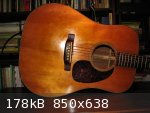
Although a single wipe is probably inconsequential, I would not oil any of my soundboards, because the people who have grieved over deeply-oiled
harpsichord soundboards have no reason to lie. And oil is no friend of glue.
As to whether a shellac or other sealer "belongs" on an oud soundboard, who knows what exactly they did in the past, but we can agree that in recent
memory many (though not all) fine ouds have been delivered with raw spruce soundboards. Clear arguments have been presented for both approaches.
|
|
|
Brian Prunka
Oud Junkie
    
Posts: 2916
Registered: 1-30-2004
Location: Brooklyn, NY
Member Is Offline
Mood: Stringish
|
|
Quote: Originally posted by Aymara  |
But let me ask a last question ... you mentioned, that even acoustic guitars once had unfinished soundboards. If varnishes / coatings have such an
influence on sound in a negative way, why then are nearly all guitars nowaday varnished completely? No offence! Just a thought.
|
I think you misunderstood what I meant; I wasn't saying that these old guitars had unfinished soundboards, but that over the past 50 years, the finish
that they once had (which was thin to begin with) has worn away/decomposed. My main point being that on old instruments, it can be difficult to tell
how they were originally finished.
Regarding the finishing of guitars nowadays, some points to consider:
1 - guitars are operating under much higher tensions and are functioning under different acoustical parameters than ouds; a finish likely has less
impact under those conditions
2 - it may be that, like a violin, the tone of a guitar is improved by certain finishes
3 - guitars are consumer goods and have thick finishes applied for reasons that have nothing to do with what makes an instrument sound good (looks and
protection primarily). Further, the finishes used on the average guitar are detrimental to the sound; they are easier, cheaper, and shinier than
traditional Shellac, Varnish, and Lacquer finishes. Based on the number of complaints I've heard from uninformed people regarding the (light,
traditional) finish on high-end Gibson and Eastman guitars, the manufacturers just want shiny, durable finishes so the masses don't complain.
4 - many high-end guitar makers (not manufacturers) use as little finish as possible on the face of the instrument.
5 - Martin and Taylor made an unfinished-top guitar a few years back (it had a light sealer coat, but by guitar standards was unfinished), which
sounded great despite being one of the cheapest models they offered. Better than some of their shiny, more expensive models.
I don't disagree that a finish helps protect the instrument. I just think that one can protect the instrument by being careful.
|
|
|
Brian Prunka
Oud Junkie
    
Posts: 2916
Registered: 1-30-2004
Location: Brooklyn, NY
Member Is Offline
Mood: Stringish
|
|
Quote: Originally posted by fernandraynaud  | An example of sorts. This Martin D-18 is guitar is 49 years old. I've had it for 43. The first 6 years of its life were harsh. The first owner treated
it rough, and (also) chewed the soundboard up with a flatpick. The finish is nitrocellulose, which is very similar to shellac, and it did its job. I
doubt the instrument would be in the shape it's in if the soundboard had been left unfinished. I can only hope my ouds are still giving someone as
much joy 50 years from now.
Brian can you show what your Shukri al-Moulki looks like? Is the soundboard exactly as you got it?
By the way, on this Martin there is no truss rod, the neck has never been reset or worked on, and the action (at the 12th fret) is still 2.5 mm on the
treble, 4 mm on the bass side. They knew how to do things.
Although a single wipe is probably inconsequential, I would not oil any of my soundboards, because the people who have grieved over deeply-oiled
harpsichord soundboards have no reason to lie. And oil is no friend of glue.
As to whether a shellac or other sealer "belongs" on an oud soundboard, who knows what exactly they did in the past, but we can agree that in recent
memory many (though not all) fine ouds have been delivered with raw spruce soundboards. Clear arguments have been presented for both approaches.
|
Oh, man, you are making me envious! That must be an amazing guitar.
I will take a couple pictures of my oud and post them.
|
|
|
Brian Prunka
Oud Junkie
    
Posts: 2916
Registered: 1-30-2004
Location: Brooklyn, NY
Member Is Offline
Mood: Stringish
|
|
The soundboard is all original except that the original soundhole was modified: the dark purfling indicates where the original soundhole was, and wood
has been added to make the soundhole smaller. The wood in the inside of the purfling is not original.
The wood for the arm protector is not original. I am not sure about the pickguard. The bridge has had some wood added to the top to raise the
action slightly. The large rosette is not original, but the small ones are. The fingerboard has been replaced.
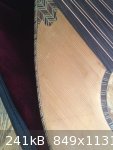
|
|
|
Brian Prunka
Oud Junkie
    
Posts: 2916
Registered: 1-30-2004
Location: Brooklyn, NY
Member Is Offline
Mood: Stringish
|
|
remaining photos
here:
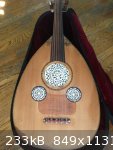
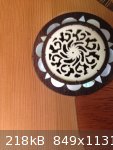
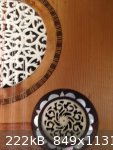
|
|
|
fernandraynaud
Oud Junkie
    
Posts: 1865
Registered: 7-25-2009
Location: San Francisco, California
Member Is Offline
Mood: m'Oudy
|
|
"Oh, man, you are making me envious! That must be an amazing guitar."
The vintage D-18s are vastly overrated I think. Big Martins are power guitars with a boomy bass. The instrument is great for volume strumming, but
not very subtle. Or you can use metal fingerpicks. The Brazilian Rosewood sides of these Martins are almost always cracked on the sharp turns, turns
out it's not a great material for that. I've tried pretty light strings but it still feels stiff. And to get that wonderful bright bronze sound
realistically it's hard to go below a 0.012-0.052 set. It's kind of a lumberjack's campfire companion. After playing oud it feels like one of those
egg-slicers with wires. I'm trying to work out a relationship with that guitar, building the finger callouses back up, etc.
That oud is beautiful! Looking at that soundboard, it looks like it's been cleaned at some point. I wonder how. I wonder why the soundhole was
reduced. Do you know?
|
|
|
Brian Prunka
Oud Junkie
    
Posts: 2916
Registered: 1-30-2004
Location: Brooklyn, NY
Member Is Offline
Mood: Stringish
|
|
It may have been cleaned with alcohol at some point (or possibly a vinegar solution?), but no abrasives have been used.
Najib Shaheen told me that his father had had the soundhole made smaller ages ago in order to improve the sound. I am not sure what the exact
improvement would have been, but since soundhole size relates to the bass response I imagine that that was a factor.
It is a beautiful oud, I will post pictures of the bowl if you like. The bowl is very deep, though, and it is a bit uncomfortable to play for long
periods.
|
|
|
| Pages:
1
2 |